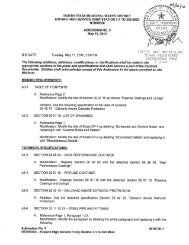final bid specs 09328.pdf - Freese and Nichols, Inc.
final bid specs 09328.pdf - Freese and Nichols, Inc.
final bid specs 09328.pdf - Freese and Nichols, Inc.
You also want an ePaper? Increase the reach of your titles
YUMPU automatically turns print PDFs into web optimized ePapers that Google loves.
C. Surface Preparation: Clean <strong>and</strong> prepare surfaces to be coated according to manufacturer's<br />
written instructions for each substrate condition <strong>and</strong> as specified.<br />
1. Cementitious Substrates: Prepare concrete,. Remove efflorescence, chalk, dust, dirt,<br />
grease, oils, <strong>and</strong> release agents. Roughen as required to remove glaze. If hardeners or<br />
sealers have been used to improve curing, use mechanical methods to prepare surfaces.<br />
a. Use abrasive blast-cleaning methods if recommended by coating manufacturer.<br />
b. Determine alkalinity <strong>and</strong> moisture content of surfaces by performing appropriate<br />
tests. If surfaces are sufficiently alkaline to cause the finish paint to blister <strong>and</strong> burn,<br />
correct this condition before application. Do not coat surfaces if moisture content exceeds<br />
that permitted in manufacturer's written instructions.<br />
D. Material Preparation: Carefully mix <strong>and</strong> prepare coating materials according to manufacturer's<br />
written instructions.<br />
1. Maintain containers used in mixing <strong>and</strong> applying coatings in a clean condition, free of foreign<br />
materials <strong>and</strong> residue.<br />
2. Stir materials before applying to produce a mixture of uniform density. Stir as required<br />
during application. Do not stir surface film into the material. Remove film <strong>and</strong>, if necessary,<br />
strain coating material before using.<br />
3. Use only the type of thinners approved by manufacturer <strong>and</strong> only within recommended<br />
limits.<br />
E. Tint each undercoat a lighter shade to facilitate identification of each coat if multiple coats of<br />
the same material are to be applied. Tint undercoats to match color of finish coat, but provide<br />
sufficient difference in shade of undercoats to distinguish each separate coat.<br />
3.03 APPLICATION<br />
A. General: Apply high-performance coatings according to manufacturer's written instructions.<br />
1. Use applicators <strong>and</strong> techniques best suited for the material being applied.<br />
2. Do not apply high-performance coatings over dirt, rust, scale, grease, moisture, scuffed<br />
surfaces, or conditions detrimental to forming a durable coating film.<br />
3. Coating colors, surface treatments, <strong>and</strong> finishes are indicated in the coating system descriptions.<br />
4. Provide finish coats compatible with primers used.<br />
5. The term "exposed surfaces" includes areas visible when permanent or built-in fixtures,<br />
convector covers, grilles, covers for finned-tube radiation, <strong>and</strong> similar components are in<br />
place. Extend coatings in these areas, as required, to maintain system integrity <strong>and</strong> provide<br />
desired protection.<br />
a. Coat surfaces behind movable equipment <strong>and</strong> furniture the same as similar exposed<br />
surfaces. Before <strong>final</strong> installation, coat surfaces behind permanently fixed equipment<br />
or furniture with prime coat only.<br />
b. Coat back sides of access panels, removable or hinged covers, <strong>and</strong> similar hinged<br />
items to match exposed surfaces.<br />
B. Scheduling Coating: Apply first coat to surfaces that have been cleaned, pretreated, or otherwise<br />
prepared for coating as soon as practicable after preparation <strong>and</strong> before subsequent<br />
surface deterioration.<br />
1. The number of coats <strong>and</strong> film thickness required is the same regardless of application<br />
method.<br />
a. Allow sufficient time between successive coats to permit proper drying. Do not recoat<br />
surfaces until coating has dried to where it feels firm, does not deform or feel<br />
High-Performance Coatings 09 96 00 - 5<br />
DPR09328












